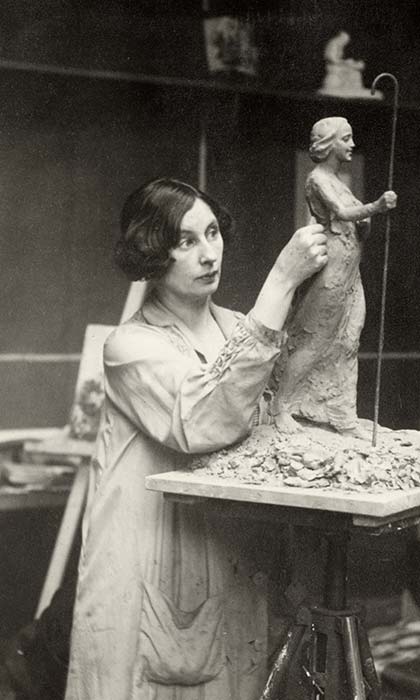Eileen May Duggan OBE
Poet, 1894-1972

AND AT THE END
Once on a dewy morning
With the blue sky blowing apart,
Each bud broke on my eyelids,
Each bird flew through my heart.
I prayed for the faith of a starling
Under the tawny trees,
child or a holy woman,
What could be greater than these?
But now on a heavy morning
With the dull sky blowing apart,
When no flower blesses my eyelids,
And no wing brushes my heart,
I, made surer by sorrow,
Beg what seems more to me,
The faith of a willow in winter,
Or a blind hound nosing the knee.
Further reading:
Margaret Butler
Sculptor, 1883 – 1947

Margaret Butler was the youngest of four children born to Irish parents Edward and Mary in Greymouth in 1883. Margaret’s father died when she was barely a year old and so the family relocated to Wellington where Mary ran a very successful hotel business.
Margaret was sent to school at St Mary’s Convent and then to the Wellington Technical School. It was here that Margaret was introduced to the sculptor Joseph Ellis (also buried in Karori) and whilst she was a capable watercolour artist, she knew that her true calling was for sculpture and so she began studying with Ellis.
One of Butler’s early works (a bust of William Hall Jones) drew international attention and it was shown at the 1924-1925 British Empire Exhibition in London. The bust is now held by Te Papa.
Between 1923 and 1934 Butler travelled to Europe, visiting Paris, Brittany, Rome Vienna and Algeria. It was during this time that Margaret’s ill heath began to show and she was unable to work for 2 years (Margaret was also born Club Footed and struggled greatly with mobility).
In 1926 whilst in Paris she met Antoine Bourdelle, one of Europe’s prominent sculptors and he took Margaret as a student. He was able to arrange for her work to be exhibited at the prestigious Salon des Tuileries, the Societe des artistes francais and at the Societe des beaux-arts. Her work attracted the attention of another famed sculptor, Charles Despiau who greatly admired Bulter’s work. In 1935 Margret’s bronze bust entitled “The Blind Girl” was exhibited at the Royal Academy of Arts in London.
When Butler finally returned to New Zealand, she was relatively unknown as an artist. Her work had however caught the attention of the then Governor, Lord Bledisloe and a major solo exhibition of her work was staged at the New Zealand Academy of Fine Arts. It was at this time that Margaret began producing some of her most famous works, portraits of Māori figures. “La Nouvelle Zeland” is the best known and is a bust of a young Māori performer named Miriama Heketa.
Despite her success as an artist, she received few commissions for work and became troubled financially. Her lifelong friend the New Zealand Poet Eileen Duggan was a huge support to Margaret during this time as once again her health began to decline. She moved to Rotorua briefly with her sister Mary but when Mary died 1943 it devastated Margaret and she returned to Wellington.
Margaret Butler died of Cancer at Lewisham Hospital in December 1947. Her funeral was attended by the Prime Minister Peter Fraser and by the Catholic archbishop Thomas O’Shea. Margaret was laid to rest in the Roman Catholic section at Karori in accordance with her devout faith. Twenty-Five years later her close friend Eileen Duggan was laid to rest close by.
